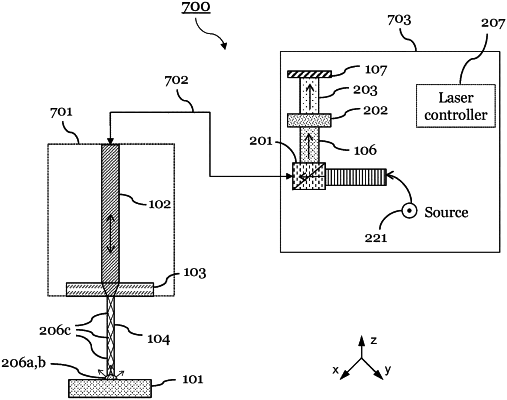| CPC B23K 26/032 (2013.01) [B05B 12/004 (2013.01); B05B 12/082 (2013.01); B23K 26/03 (2013.01); B23K 26/146 (2015.10); B23K 26/1462 (2015.10); B23K 26/707 (2015.10); B23K 26/1476 (2013.01)] | 12 Claims |

|
1. Apparatus (100, 200, 300, 700) for machining a workpiece (101) with a laser beam (102), the apparatus (100, 200, 300, 700) comprising
a laser configured to provide the laser beam (102), wherein the laser includes a light sensor;
a machining head including a nozzle (302) and a lens (305);
an optical fiber optically connecting the machining head and the laser; and
a computer (109)
wherein the nozzle (302) is configured to provide a pressurized liquid jet (104) onto the workpiece (101), wherein the liquid jet (104) has a diameter in the micrometer range;
wherein the lens (305) is configured to receive the laser beam (102) via the optical fiber from the laser, and to couple the laser beam (102) into the liquid jet (104) towards the workpiece (101);
wherein the light sensor (107) in the laser is configured to receive, during the machining of the workpiece (101) with the laser beam (102), a back-propagating laser-induced electromagnetic secondary radiation (206a, 206c) and to convert the received secondary radiation (206a, 206c) into a signal (108), wherein the back-propagating secondary radiation (206a, 206c) is guided in and by the liquid jet (104) and through the lens (305) for coupling the laser beam (102) into the liquid jet (104); and
wherein the computer (109) configured to determine based on the signal (108), during the machining of the workpiece (101) with the laser beam (102), whether the laser beam (102) has broken through the workpiece (101).
|